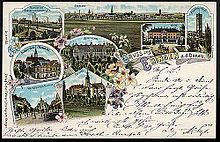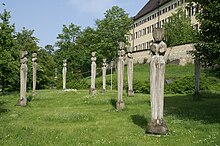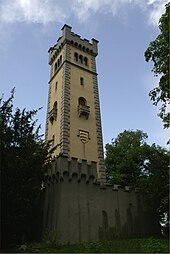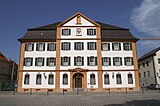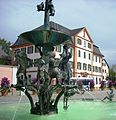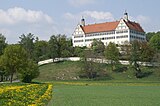Ehingen (Danube)
| coat of arms | Germany map | |
|---|---|---|

|
Coordinates: 48 ° 17 ' N , 9 ° 43' E |
|
| Basic data | ||
| State : | Baden-Württemberg | |
| Administrative region : | Tübingen | |
| County : | Alb-Danube district | |
| Height : | 515 m above sea level NHN | |
| Area : | 178.37 km 2 | |
| Residents: | 26,259 (Dec. 31, 2018) | |
| Population density : | 147 inhabitants per km 2 | |
| Postal code : | 89584 | |
| Primaries : | 07391, 07386 , 07392 , 07393 , 07395, 07375 | |
| License plate : | UL | |
| Community key : | 08 4 25 033 | |
| City structure: | Core city and 17 districts | |
City administration address : |
Marktplatz 1 89584 Ehingen (Danube) |
|
| Website : | ||
| Lord Mayor : | Alexander Baumann ( CDU ) | |
| Location of the city of Ehingen (Danube) in the Alb-Danube district | ||

Ehingen (Danube) is a city in the southeast of Baden-Württemberg , around 23 kilometers southwest of Ulm and 67 kilometers southeast of Stuttgart . The largest city in the Alb-Donau district is a medium-sized center for the surrounding communities .
Ehingen has been a major district town since January 1st, 1974 . The city has entered into an agreed administrative community with the neighboring communities of Griesingen , Oberdischingen and Öpfingen . The part of the Ehingen district on the Alb plateau (33.8%) belongs to the Swabian Alb biosphere area .
From 1346 to 1805, the town and the surrounding area belonged to Upper Austria , which the Ständehaus on the market square still bears witness to today.
geography
location
Ehingen is located on the southern edge of the Mittlerer Flachalb on the northern bank of the Danube in a loop of the Schmiech river . This small river rises around 20 km north of Ehingen in the Lutheran Mountains , reaches the urban area near Berkach, crosses the city center and flows southeast of it into the Danube.
The Danube only touches the city in the extreme southeast. Coming from Munderkingen and Rottenacker, it enters the urban area at the Herbertshofen district, then flows in a north-easterly direction past the Dintenhofen and Dettingen districts , between the core city in the north and the Berg district in the south, before it picks up the Schmiech and then south of the districts Nasgenstadt and Gamerschwang runs, to finally leave the urban area northeast in the direction of Ulm.
The Rißissen district is an exclave about eight kilometers east of the city center in the Danube plain on the Riss , which flows into the Danube just a little further north.
On the western edge of Ehingen, the terrain rises by over 200 meters to the Ehinger Alb and the Stoffelberg (730 m). Numerous hiking trails that are linked to the Ehinger Alb reflection trail run along this undulating plateau to Mundingen .
Neighboring communities
The following cities and municipalities (unless otherwise noted, they belong to the Alb-Donau district) border the city of Ehingen ( clockwise , starting in the north):
Schelklingen , Allmendingen , Altheim , Öpfingen and Griesingen , Laupheim and Schemmerhofen (both districts of Biberach ), Unterstadion , Rottenacker , Munderkingen , Untermarchtal and Lauterach as well as Hayingen and Münsingen (both districts of Reutlingen ).
City structure
The city consists of the core city , which also includes the municipalities of Dettingen and Berkach, which were incorporated in 1939 , and the municipalities of Altbierlingen , Altsteusslingen , Berg , Dächingen , Erbstetten , Frankenhofen , Gamerschwang , Granheim , Herbertshofen , Heufelden , which were incorporated as part of the municipal reform of the 1970s , Kirchbierlingen , Kirchen , Mundingen , Nasgenstadt , Rississen , Schaiblishausen and Volkersheim . The former municipalities are also towns within the meaning of Baden-Wuerttemberg Municipal Code, that is, they each have one of the eligible voters in each local election to be elected Ortschaftsrat with a mayor as chairman. In every village there is a local administration, so to speak a "town hall on site", the head of which is the mayor.
Some parts of the city still have spatially separate residential areas with their own names, which, however, usually have only a few inhabitants, or residential areas with their own name whose names have emerged in the course of development and whose boundaries are usually not precisely defined. Such living spaces are:
- in the city center: Jägerhof, Käshof, Saurücken, Steinhoflehen and Ziegelhof
- in Berg: Ernsthof
- in Erbstetten: Vogelhof
- in Frankenhofen: Karlshof
Spatial planning
Ehingen is a medium-sized center within the Donau-Iller region with the city of Ulm as the regional center . In addition to Ehingen itself, the following towns and communities in the Alb-Donau district belong to the central area of Ehingen: Allmendingen , Altheim , Emeringen , Emerkingen , Griesingen , Grundsheim , Hausen am Bussen , Lauterach , Munderkingen , Oberdischingen , Obermarchtal , Oberstadion , Öpfingen , Rechtenstein , Rottenacker , Untermarchtal , Unterstadion and Unterwachingen .
history
Prehistory and Antiquity
The first people probably settled in the Ehingen area as early as the Neolithic , a few finds confirm this. References to the Celts are sparse. In Roman times, Ehingen was probably an important transit point (Heerstraße).
Early Middle Ages
The Alemannic immigration followed, with which the history of the place Ehingen ( -ingen indicates) began. An Alemanni cemetery on the Schmiech testifies to this as well as important finds from the years 1929 and 1930. The first documented mention of Ehinga is contained in an exchange document from the Chur diocese and Schwarzach monastery from 961. The settlement was in the Schmiechniederung at the site of today's Lower City .
From Schelklingen to Upper Austria
The actual foundation of the city was done by the Counts of Berg-Schelklingen next to their castle over the Schmiech. Today's coat of arms reminds of them. The Berkach district was mentioned in a document as early as 787 when it was donated to Lorsch Abbey in the Lorsch Codex . Ehingen is very likely mentioned in this document, but the place name Heingen is not sufficiently clear.
After the Berger Count House died out, Ehingen fell to the House of Austria in 1346 and thus to their Swabian foothills . However, the financially weak Habsburgs soon pledged the city to various nobles. This circumstance, as well as the growing prosperity of the citizens, made it possible to acquire important rights that came close to those of the imperial cities .
Between 1498 and 1511, the future Emperor Maximilian stayed within the walls of Ehingen six times. The Ehingen-born Winckelhofer brothers, the poet Jakob Locher and the sculptor Jörg Muskat belonged to his circle of friends .
After the Thirty Years' War Ehingen was a regular meeting point for the Swabian-Austrian estates; The venue was the Ständehaus on the market square. From 1689 until its dissolution in 1806, the city was also the seat of the knightly canton of Danube . Fires of 1688 and 1749 left clear marks on the cityscape.
Around 1790, an accurate map of this area of Upper Austria was created for the first time by the Tyrolean peasant cartographer Anton Kirchebner . However, it was no longer printed because of the French wars that broke out in 1793 .
Württemberg time
In the Peace of Bratislava in 1805, the Austrian Empire had to cede its foothills to the allies of the French Empire . After more than four and a half centuries of Austrian rule, Ehingen came to the newly created Kingdom of Württemberg . As early as the following year, the city became the seat of the Oberamt Ehingen as part of the new Württemberg administrative structure .
In the famine year of 1816 , the need came to Ehingen, which, thanks to good supplies in the hospital box, was milder than in other municipalities and cities in Central Europe. An urban fire engine had been available since 1717, but the volunteer fire brigade was not founded until July 18, 1861. In 1869 the Ulm – Sigmaringen railway reached the city, which provided a connection to the Württemberg railway network . From the middle to the end of the 19th century, the industry developed strongly and with it the city. Breweries were important (21 in 1890; Ehingen still has four breweries today) and construction (Ehingen cement works 1890–1925).
20th century
The administrative reforms during the Nazi era in Württemberg made the district of Ehingen out of the Oberamt in 1934 , which in 1938 became part of the new district of Ehingen .
In 1937 the Schwäbische Zellstoff AG (now Sappi) settled in Ehingen.
From 1945, like the entire district of Ehingen, the city belonged to the French zone of occupation and first came to the post-war state of Württemberg-Hohenzollern and from 1952 to the administrative district of Südwürttemberg-Hohenzollern in the new state of Baden-Württemberg.
After the Second World War , the Schlecker company rose. It started with a butcher's shop in Tuchergasse in 1902 and then moved to Bahnhofstrasse.
In the course of the district reform in Baden-Württemberg in 1973, the majority of the Ehingen district was merged with the Ulm district to form the new Alb-Danube district , and some communities in the Ehingen district became the enlarged Biberach district . Ehingen thus lost its function as a district town . As a result of the incorporation of 17 districts, the population exceeded the limit of 20,000, and Ehingen was elevated to a major district town on January 1, 1974 . Some tasks of the district were thus transferred to the city of Ehingen, so that the loss of the district seat was partially compensated for. In Ehingen there is a branch of the Alb-Danube District District Office.
Incorporations
The following communities were incorporated into the city of Ehingen (they all belonged to the district of Ehingen before the district reform).
- 1939: Berkach and Dettingen
- August 1, 1971: Nasgenstadt
- May 1, 1972: Berg , Kirchen (with mills, Schlechtenfeld, Stetten, Deppenhausen , Mochental)
- October 1, 1972: Altsteußlingen (with Briel), Gamerschwang , Heufelden (with Blienshofen )
- January 1, 1973: Altbierlingen , Kirchbierlingen (with Weisel , Sontheim ), Schaiblishausen (with Bockighofen ), Volkersheim
- December 1, 1973: Dächingen , Erbstetten (with Unterwilzingen , Vogelhof), Frankenhofen (with Tiefenhülen ), Herbertshofen (with Dintenhofen ), Mundingen
- January 1, 1974: Granheim
- January 1, 1975: Rississen
Population development
Population figures according to the respective area. The figures are census results (¹) or official updates from the respective statistical offices ( main residences only ).

|
|
¹ census result
Religions
Denomination statistics
On December 31, 2017, 54.5% of the residents were Catholic , 14.9% Protestant , 33.7% belonged to another religion or were non-denominational .
Catholic Church
The area of today's city of Ehingen initially belonged to the diocese of Constance and was subordinate to the Archdiaconate circa Alpes . As a result of belonging to Austria, the Reformation was not introduced, so that the city area remained predominantly Catholic for many centuries . In contrast, the Reformation was introduced in the Mundingen district in 1535, as it belonged to Württemberg. The first Ehingen church was mentioned in 1182. In 1339 it appeared as a church consecrated to St. Blasius .
Today's St.Blasius / Theodul Church ( Theodul von Sitten († 400) is also the city's patron saint) is a building from the 18th century with the tower from 1888. A Church of Our Lady was donated in 1239 by the Counts of Berg and founded in 1639 and 1630 Franciscan monastery handed over. It was rebuilt in 1723/25. The monastery building is now used by the cultural office. Another Catholic church is the Herz-Jesu-Kirche (formerly the church of the Benediktinerkolleg) - Konviktskirche - from 1712/19 with a tower from 1885. In 1970 the St. Michael's Church was built. The Catholics of the core city and of Altsteusslingen, Berkach, Dettingen and Herbertshofen belong to the two parishes of St. Blasius and St. Michael. In Altsteußlingen there is a church from 1756 with a Gothic choir and a new tower from 1970. In Dettingen there is the St. Leonhard Chapel, which was built in 1765, and in Dintenhofen a chapel from 1705. The Catholics from Heufelden also belong to Ehingen. There is the branch parish of St. Gangulf with a church from the 14th century, which was extended in 1904. In the associated hamlet of Blienshofen there is the St. Georg chapel from 1485, which was renovated in the 18th century.
In the other districts of Ehingen there are the following Catholic parishes: Dächingen (“ to the painful mother ”, built into the former tithe barn in 1848), Erbstetten (late Gothic St. Stephen's Church; St. Georg Unterwilzingen branch chapel, built in 1908 including the old building from 1724), Frankenhofen (St. Georg, built 1674 with an older tower and choir; late Gothic chapel in Tiefenhülen), Gamerschwang (St. Nikolaus, 1689 with an extension from 1870), Granheim (St. Martinus, 17th century, with a Gothic tower, The parish also includes the Catholics from Mundingen), Kirchbierlingen (St. Martinus, built in 1513 with Romanesque remains; Schaiblishausen with the St. Magnus and Leonhard chapel built in 1890, Volkersheim with the Wendelins chapel built in the 18th century, Altbierlingen also belong to the community a St. Wendelin chapel and mountain with the branch church St. Ulrich), churches (St. Martinus, 18th century with late Gothic tower, further chapels in the associated one n hamlets of Deppenhausen, Mochental, Mühlen, Schlechtenfeld and Stetten), Nasgenstadt (St. Petrus and Paulus, built in 1729 with a tower from 1749) and Rississen (St. Pankratius and St. Dorothea, built in 1787, St. Leonhard's cemetery chapel from 1483 and the Staufenberg crypt chapel from 1873).
All the above-mentioned Catholic parishes belonged to the diocese of Constance until the beginning of the 19th century and then to the Ehingen regional chapter. Since 1821 they have belonged to the Diocese of Rottenburg, now the Diocese of Rottenburg-Stuttgart . The former dean's office in Ehingen was merged with the dean's office in Ulm in 2008 to form the new dean's office in Ehingen-Ulm , based in Ulm.
Protestant church
From the beginning of the 19th century, more and more members of the Protestant Church moved to Ehingen, later also to the other now Catholic districts of Ehingen. At first they were looked after by the parish of Rottenacker . In 1848 a branch church was established in Ehingen and in 1879 a Protestant church was built. It has had its own parish since 1889. The Wenzelstein parish center with its own parish was established in 1971. Today, the two parish districts Ehingen-Nord and Ehingen-Süd form the Protestant parish Ehingen, which together with Allmendingen forms the entire parish of Ehingen within the church district of Blaubeuren of the Evangelical Church in Württemberg .
The parish of Ehingen also looks after most of the Protestant residents of the Ehingen districts. Frankenhofen belongs to the parish of Weilersteusslingen, Herbertshofen, Kirchbierlingen and Volkersheim looks after the parish of Rottenacker. In the Mundingen district there is its own Protestant parish, which has existed since the Reformation because this place was already part of Württemberg at that time. The parish church there was rebuilt in 1790. This parish, to which the Protestants from the districts of Dächingen, Erbstetten, Granheim and Kirchen also belong, is part of the Bad Urach-Münsingen church district . The district of Rississen belongs to the parish of Ersingen (city of Erbach ) in the church district of Biberach .
Other Christian churches
In addition to the two large churches, there are also free church communities in Ehingen , including the Arche Volksmission. The New Apostolic Church is also represented in Ehingen.
Muslims
Almost all Muslims in the city are followers of Sunni Islam . One large and two smaller mosques or places of prayer from different providers are available to you. Most of the Muslim residents of Ehingen have a migration background . The elderly were recruited as guest workers in the early 1960s , mainly from Turkey . Most of them already live in the third generation in Ehingen.
The great Mevlana - Mosque in Ehingen, with a 21 meter high minaret and a dome with a diameter of 9 meters, was completed of 2003. The prayer room can accommodate around 600 people. In addition to the ornamental paintings on the walls, the 5 meter high and 700 kg heavy glass crystal chandelier with a diameter of 2.5 meters is worth seeing . The building was financed with donations and membership fees from local Muslims. The carrier is the Turkish-Islamic Association DITIB .
politics
Municipal council
The local elections on May 26, 2019 led to the following result with a turnout of 53.9% (2014: 49.0%):
| Party / list | Share of votes | W / l% p | Seats | G / V |
| CDU | 53.0% | - 7.6 | 19th | - 2nd |
| SPD | 9.7% | - 2.5 | 3 | - 1 |
| Green | 18.4% | + 6.5 | 7th | + 3 |
| Free | 8.3% | - 1.1 | 3 | ± 0 |
| Young marriage | 8.0% | + 2.0 | 3 | + 1 |
| FDP | 2.6% | + 2.6 | 1 | + 1 |
mayor
At the head of the city of Ehingen in the times of the Counts of Berg there was initially an Ammann, also mayor, who was appointed from the citizenry. Around 1290, a council elected by the guilds was named, headed by the mayor. From 1444 the Ammann was freely elected. From 1568 there were three mayors who formed the inner council . One of them was the mayor at the head of the city government. From 1748 Ehingen was subordinate to the Oberamt Burgau (seat in Günzburg). The official business in Ehingen was carried out by an Austrian bailiff who was assisted by an overridden . From 1756 there was a narrow deputation , an internal and an external council . A city school was used during the Württemberg period. From 1818 there was also a council again.
In 1935, out of the city mayor, the mayor of the official title since the survey to district town in 1974 Mayor carries. The Lord Mayor is currently elected for a term of eight years. He is chairman of the municipal council and head of the city administration. His deputies are the first alderman and the alderman, both with the official title of mayor .
The city leaders of Ehingen since 1700:
|
|
coat of arms
The coat of arms of the city of Ehingen is divided diagonally five times by silver and red. The city flag is white and red.
The coat of arms appeared in the city seals as early as 1304. It was the coat of arms of the Counts of Berg , the city lords of that time. In the 18th century the five inclined beams were replaced by three inclined beams. The regional council of Tübingen awarded the coat of arms in its original form on February 19, 1979.
Twin cities
Ehingen maintains since 1992 with the city of Esztergom in Hungary , a city partnership .
Economy and Infrastructure
traffic
Ehingen is located on the railway line Ulm-Sigmaringen (also Danube railway called) and Regional Express -Stop. The regional express trains run every two hours between Ulm and Sigmaringen and also every two hours between Ulm and Donaueschingen (sometimes also to Villingen ), so that there is an hourly service to Sigmaringen. Ehingen is also part of the hourly regional train line Ulm-Munderkingen. This means that trains to Ulm run every half hour. The city is part of the Donau-Iller-Nahverkehrsverbund (DING).
The federal road 465 ( Kirchheim unter Teck - Leutkirch im Allgäu ), the federal road 311 (Ulm - Geisingen ) and the federal road 492 ( Blaubeuren - Ehingen) connect Ehingen to the national road network.
Ehingen is on the Danube Cycle Path , which divides there. The direct route leads along the Danube via Erbach to Ulm; the more scenic one runs over the Urdonautal towards Blaubeuren , which is now crossed by the blue . The two branches reunite in Ulm.
Local businesses
Companies in the city are Liebherr (vehicle and crawler crane construction, over 3000 employees), Sappi (paper factory, over 500 employees), HTE Tries (hydraulic elements), Möbel Borst, the Berg brewery in the Berg district and the machine and plant manufacturer Kottmann. Ehingen has a total of four small, economically independent beer breweries and, after winning the "Tourist ideas competition for the Genießerland Baden-Württemberg", describes itself as a city of beer culture . Ehingen was known nationwide as the seat of the former drugstore chain Schlecker , which had branches throughout Germany and other European countries.
media
The Schwäbische Zeitung Ehingen and the Ehinger Tagblatt, a local edition of the Südwest Presse, appear in the city . The online news portal wir-sind-Ehingen.de has existed for several years .
Court and bodies
The district court of Ehingen belongs to the regional court district of Ulm and the OLG district of Stuttgart . Other authorities are a branch of the Alb-Donau-Kreis district office and the tax office .
The Ehingen District Hospital has 198 beds in the departments of surgery, internal medicine, obstetrics / gynecology, ear, nose and throat and urology. A dialysis center is also available. The BruderhausDiakonie operates facilities for disabled people and social psychiatry in Ehingen .
education
The city of Ehingen is responsible for the Johann-Vanotti-Gymnasium Ehingen , the Realschule Ehingen and the Hermann-Gmeiner-Schule ( special school ). It also maintains two primary and secondary schools (Längenfeld primary and secondary school and Michel Buck School), one secondary school (in Kirchbierlingen) and five independent primary schools (Berg, Erbstetten and Frankenhofen, primary school in the old Konvikt, churches and Rississen).
The Alb-Donau-Kreis is responsible for the vocational schools (vocational school, commercial school and Magdalena-Neff school - home and agricultural school), the Schmiechtal school for the mentally handicapped with a school kindergarten and the nursing school at the Ehingen district hospital.
From 1983 to 2009 the theological pre-seminar Ambrosianum of the Diocese of Rottenburg-Stuttgart , which was then moved to Tübingen, was located in Ehingen , where you can acquire the Hebraicum , Graecum , large Latinum and basic knowledge of philosophy in one year.
Pupils who attend the surrounding schools live in the Catholic boarding school, St. Josef College .
The private vocational school of the International Federation e. V. (IB) rounds off the school offerings in Ehingen.
Culture, sports and sights
Ehingen is located on the Upper Swabian Baroque Road and the German Half-timbered Road . The Blauer Steinbruch nature reserve is located on the western outskirts of the city . Since 2009, the Upper Swabian Pilgrim Trail , a spiritual hiking trail, has also been running through Ehingen with its loop 6 .
Churches
The towers of the three churches Liebfrauen, Herz-Jesu and St. Blasius are the city's landmarks . There are (mostly Catholic) churches in all parts of the city (for more details, see the Religions section)
- The Liebfrauenkirche is an example of Franciscan Baroque and has a closed interior design.
- The Herz-Jesu-Kirche ( Konviktskirche ) with a cross-shaped floor plan and attached Konvikt comes from the school of the Vorarlberg baroque master builder Franz Beer , the furnishings were largely destroyed during the secularization
- The Church of St. Blasius (town parish church) is a Gothic church with baroque changes and some remarkable Renaissance altars (including the Winckelhofer Altar)
Museums and galleries
- Museum of the city of Ehingen in the former Heilig-Geist-Spital, built in 1340 (since 2016 Infsotelle of the UNESCO Geopark Swabian Alb )
- Broom museum and private gallery in the baroque Mochental Castle
- Roman Museum in the Riississen School
- Pastor Dr.-Walz-Saal in the rectory in Erbstetten
- Feigel fashion museum in the former Granheim school building
- Granheim tower clock museum with motorcycle and equipment collection
- Old saw in Mundingen
- Brewery museum in Berg der Berg Brewery, museum in the old brewery
- Städtische Galerie Ehingen , modern art and collection Doris Nöth in Ehingen
- 's Bäumle in Berg , gallery-café-art cellar
Other structures
- The estate building on the market square served as the official building of the Swabian-Austrian estates from 1769/70 to 1805; today it is the district court
- The Heilig-Geist-Spital houses the collections of the city museum
- Reconstructed battlement
- The Mochental Castle
- The Wolfert Tower , a 30 m high observation tower from 1891, built as the Kaiser Wilhelm Memorial Tower
- The former Franciscan monastery now serves as a cultural center
- The Mevlana Mosque with dome and minaret, built between 2002 and 2003
- At the market square the Theodulbrunnen with the legend of the devil and scenes from city life
- The 107 meter high chimney of the Sappi paper mill, a chimney designed as a steel lattice tower
Ziegelhoflinde
The old linden tree in the Ziegelhof ⊙ , a district of the core town of Ehingen, is one of the oldest and most unspoilt trees in Baden-Württemberg. It is in the small hamlet, 2.5 km northwest of the city center, by the “Jägerhof” school camp. The earth trunk, which has broken several times and is partially hollow, carries two powerful horizontal branches and a significantly slimmer, vertical central trunk. The two almost horizontal cross branches are supported by supports in order to secure them against breaking off due to their own weight or snow load in winter. As natural monument (ID 84250330171) reported and in the prominent list and old tree specimens registered Sommerlinde has an estimated age of 800 to 1,000 years. The tree veteran, on which maintenance and care measures have already been carried out several times, has a trunk circumference of almost 9.5 meters.
regional customs
Ehingen is a Fasnets -Hochburg. The oldest reports on carnival events are a few hundred years old. One of the main characters of the Ehinger Fasnet, the "Muckenspritzer", refers to an alleged church tower fire on August 27, 1859, during which the "smoke cloud" turned out to be a gigantic swarm of mosquitoes. The fool's guild “Spritzenmuck” dates back to the 1920s and was founded in its current form in 1955. More fools guilds from Ehingen have emerged in recent years.
A custom that has not been proven anywhere else is the so-called Huzzla-Ra . On the Saturday of the church festival , after the twelve-bell tolls, huzzla (dried pears), bread rolls, sausages and sweets are thrown from the tower of the town church and picked up by the youth. A couple of buckets of water, which soaks the all too cheeky, provide additional fun for the audience.
Sports
The largest club in town is TSG Ehingen 1848 with around 2,000 members. The basketball club Team Ehingen / Urspringschule emerged from TSG Ehingen and has played in the second highest division in Germany, ProA , from 2011–2015 and since 2016 . The men's soccer team of SSV Ehingen-Süd, founded in 1974, plays in the Württemberg Association League . Every summer since 1987, first-class teams from all over Europe have been competing in the handball tournament Sparkassen-Cup .
Personalities
Honorary citizen
- Joseph Christian Schliz (1781–1861), senior bailiff, honorary citizen on January 21, 1818
- Joseph Hehle (1842–1928), rector of the Ehingen grammar school, honorary citizen on August 4, 1875
- Anton Hoch (factory director) (1842–1919), director of the cement factory of the Stuttgart real estate and construction business in Ehingen, honorary citizen on June 4, 1912
- Hans von Kolb (1845–1928), director of the Royal School of Applied Arts in Stuttgart, appointed on August 17, 1925
- Georg Zoller (1852–1941), music director, honorary citizen on May 13, 1932
- Bernhard Krieg (1868–1943), senior director of studies, rector of the grammar school, founder of the antiquity association for the Ehingen district, honorary citizen on March 1, 1934
- Wilfried Henger (1926–2011), retired Lord Mayor D., appointed June 11, 2006
sons and daughters of the town
- Anno of Cologne (1010-1075), Bishop of Cologne and saint
- Jakob Locher (1471–1528), humanistic writer and translator
- Jakob Bidermann (1578–1639), baroque playwright
- Christophorus Anton Krafft von Festenberg auf Frohnberg (1693–1765), syndic and state deputy of the Swabian estates
- Carl Anton von Krafft (1743–1830), senior magistrate and district judge of the county of Nellenburg
- Johann Kaspar Ruef (1748–1825), lawyer, librarian and professor in Freiburg
- Adolf Schliz (1813–1877), city doctor in Heilbronn
- Ferdinand Probst (1816–1899), theologian and rector of the Friedrich-Wilhelms-Universität Breslau
- Johann Evangelist Schöttle (1819–1884), pastor and local history researcher
- Josef Probst (1823–1905), Roman Catholic pastor, geologist and paleontologist
- Franz Xaver Kolb (1827–1889), church painter
- Hans von Kolb (1845–1928), director of the Royal School of Applied Arts in Stuttgart
- Hermann Widmer (1871–1940), painter and artisan
- Hans (Johann Nepomuk) Mantz (1872–1938), Lord Mayor of Ravensburg 1922–1932
- Franz Schenk von Stauffenberg (1878–1950), born in Rississen, entrepreneur and politician, member of the state and Reichstag
- Karl Rapp (1882–1962), founder and owner of the Munich Rapp engine works
- Clemens Bauer (1899–1984), economic historian
- Albert Pfitzer (1912–2000), Director of the Federal Council (1951–1978)
- Ventur Schöttle (* 1929), politician ( CDU )
- Tilmann Beller (1938–2012), theologian, educator and priest, leader of the international Schoenstatt Movement
- Fritz Vögtle (1939–2017), chemist and university professor
- Anton Schlecker (* 1944), entrepreneur
- Konrad Dettner (* 1951), zoologist and university professor for ecology
- Johannes C. Weiss (1953-2006), journalist
- Karl-Heinz Ott (* 1957), writer
- Edith Schreiner (* 1957), Lord Mayor of the City of Offenburg
- Ursula Zeller (* 1958), art historian, curator and museum director
- Peter Hepp (* 1961), deaf-blind pastor and author
- Ulrike Cress (* 1965 in Mundingen), psychologist, professor at the University of Tübingen
- Michael Glöckner (* 1969), cyclist
- Markus Götz (* 1973), handball player, sports commentator and presenter
- Zoltan Sebescen (* 1975), football player
- Manuel Hagel (* 1988), politician (CDU), member of the state parliament
Associated with Ehingen
- Heinrich Winkelhofer (around 1481–1526), law professor, judge of the Swabian Confederation, Württemberg chancellor
- Matthias Ob (around 1524 – around 1572), officiated around 1550 as a Catholic. Pastor of Ehingen, later Auxiliary Bishop in the Prince Diocese of Speyer and Titular Bishop of Daulia
- Augustin Steinhäuser (1781–1849), administrative officer, senior magistrate in Ehingen
- Michel Buck (1832–1888), Swabian dialect poet, cultural historian, senior medical officer in Ehingen
- Eugen Gaus (1850–1934), a teacher in Ehingen, discovered the cement deposits in the city
- Julius Brzoska (1859–1930), classical philologist and grammar school director, spent his retirement in Ehingen
- Rita von Gaudecker (1879–1968), writer
- Magdalena Neff (1881–1966), Germany's first licensed pharmacist
- Richard Blankenhorn (1886–1968), Württemberg educator and politician
- Wolfgang Lackerschmid (* 1956), jazz musician, band leader and composer
- Christina Diggance (* 1966), politician, chairwoman of the small party Die Violetten - for spiritual politics
literature
- Erich Keyser (Ed.): Württembergisches Städtebuch: Vol. IV, Teilbd. Baden-Württemberg, Vol. 2 . From: German City Book: Handbook of Urban History - On behalf of the Working Group of Historical Commissions and with the support of the German Association of Cities, the German Association of Cities and the German Association of Municipalities . W. Kohlhammer, Stuttgart 1961.
- Johann Daniel Georg von Memminger : Description of the Oberamt Ehingen . Cotta-Verlag, Stuttgart and Tübingen 1826.
- Wolf-Henning Petershagen: The truth about Deppenhausen: strange place names in Baden-Württemberg . Theiss, Stuttgart 2003, ISBN 3-8062-1442-5 .
- Weber, Franz Michael: Ehingen: History of an Upper Swabian Danube City . Edited by the city of Ehingen (Danube). 2nd, unchanged edition 1980 (1st edition 1955).
Web links
- Ehingen (Danube) at LEO-BW
- Website of the city of Ehingen (Danube)
- Internet presence of the beer culture city Ehingen (Danube)
Individual evidence
- ↑ State Statistical Office Baden-Württemberg - Population by nationality and gender on December 31, 2018 (CSV file) ( help on this ).
- ↑ Minst, Karl Josef [transl.]: Lorscher Codex (Volume 5), Certificate 3298, December 20, 787 - Reg. 1987. In: Heidelberger historical stocks - digital. Heidelberg University Library, p. 144 , accessed on April 22, 2018 .
- ↑ Glöckner, Karl [Ed.]: Codex Laureshamensis (Volume 3), Document 3298 (Reg. 1987) and footnote 1 to it. In: Heidelberg historical holdings - digital. Heidelberg University Library, p. 116 , accessed on April 22, 2018 .
- ^ Federal Statistical Office (ed.): Historical municipality directory for the Federal Republic of Germany. Name, border and key number changes in municipalities, counties and administrative districts from May 27, 1970 to December 31, 1982 . W. Kohlhammer, Stuttgart / Mainz 1983, ISBN 3-17-003263-1 , p. 527, 542 and 543 .
- ↑ City of Ehingen Statistical Data , accessed on February 8, 2020.
- ^ City of Ehingen (Danube), municipal council election 2019, final result , accessed on September 24, 2019
- ↑ DB travel information. Retrieved May 24, 2020 .
- ↑ Ehingen Mill. Sappi Ehingen GmbH, accessed on May 24, 2020 .
- ↑ Tourist routes . In: Swabian Alb! traveling there, of course, the nature place to go . ed. from the Swabian Alb Tourism Association. Bad Urach 2010; P. 10f.
- ↑ Wolfert Tower gives Ehingen an incredible panoramic view in the news portal for Ehingen from August 5, 2013, accessed on April 17, 2015
- ^ View from west to east of Sappi-Zellstoff-Fabrik-Ehingen
- ↑ "Ziegelhoflinde bei Ehingen" in the tree register at www.baumkunde.de
- ↑ "Summer lime tree 'Ziegelhoflinde' at the Ziegelhof in Ehingen" in Monumental Trees at monumentaltrees.com
- ↑ "Tree preservation for particularly old trees: The Ziegelhoflinde near Ehingen" at arboristik.de



